Borghese Gallery
In addition to getting checked in at our "VRBO" (Vacation Rental By Owner) apartment, they were able to visit the Borghese Gallery and gardens.It apparently had some cool sculptures by Bernini.
 |
| Pluto and Persephone, 1622, by Bernini |
I love the determination on David's face here.
 |
| David, 1622, by Bernini |
Outside the Borghese Gallery are extensive gardens.
Later that night, Linette, Erika and I arrived in Rome at about 11pm. I texted Jared and said, "We landed in Rome." He texted back, "Same." (?)
There was a grand piano in the airport that said, "Play me", so Erika sat down and played a little ditty, and people clapped.

Roman Colosseum
Our apartment was just two blocks from the Colosseum, and our schedule was completely blown anyway, so even though it was midnight by the time Sharon got us settled in the apartment, Linette and I still headed out to take a peek at the Colosseum at night, which was a great end to my birthday.
The next morning we headed out for a day exploring Rome!
Our first stop was the Colosseum, which was right down the road. It was built in 80 A.D, and is still pretty impressive.
We all spent some time listening to Rick Steve's free audio guides of this and other sites.
With all the exits, it is said that the Colosseum could be cleared in 15 minutes.
The arena originally had a wooden floor (part of which has been rebuilt to show what it used to be like).

Under that floor were two stories of rooms that were where the gladiators would go, and where animals were kept. There were a series of trap doors and elevators on pulleys, so a door would open, up would come a gladiator or a lion, and then it would go back down and close.
I think it is cool that we can look at 2,000-year-old inscriptions and still read the letters, since that's where ours came from. We can even still sort of make out many of the words, since our language has a lot of Latin.
The cousins had fun hanging out together.
"Shall he live or die?"
"DIE!!"
"Just kidding!!"
Speaking of kidding, apparently the gladiators used to put little bags of animal blood in pouches so that when they punched each other blood could splash in a crowd-pleasing way, and although people did die sometimes, many times they lived to fight another day.
Earthquakes have knocked over some of the taller walls on one side. The slopes used to be covered with benches that people would sit on. It stands as a testament to the construction that even after the city was sacked that this thing was just too big to knock down, and so it remains largely standing.
They used to have statues in each of these doorways. So, to make it more realistic, Sharon had us pose accordingly.
This side of the Colosseum has some modern brick that was added to shore things up after an earthquake collapsed the southern side.

The Arch of Constantine is found just outside the Colosseum, and was dedicated in 315 A.D. to commemorate the triumph of Constantine over Maxentius at the Batle of Milvian Bridge in 312. It spanned the road used by emperors to enter the city.
The Roman Forum
Next to the Colosseum is the Roman Forum, which is a rectangular forum (plaza) surrounded by the ruins of ancient government buildings. For centuries it was the center of Roman public life. |
| Triumphal arch |
 |
| Temple of Romulus, 307 A.D. |
 |
| Erika in Batman tennis shoes. 2016. |
 |
| Temple of Antoninus and Faustina, 141 A.D. (see below). |
People used to gather in the flat area here for markets, trials, triumphal entries, etc.
I was surprised that these pillars could remain standing for 2,000 years without being knocked down by teenagers.
House of the Vestal Virgins (Atrium Vestae) was a 3-story 50-room palace built around a double pool. An archeological dig discovered a hoard of 397 gold coins.
And here are some more pictures of us with forum-y stuff in the backgrounds.
Dr. Suess appears to have been responsible for planting the trees here.
We listened to Rick Steve's audio walking tours to try to make sense of what we were seeing.
Here is a view of the Colosseum from atop the tall structure we climbed up. (These pictures are a mix from everyone's cameras. Sharon took this one.)
There were little fountains all over Rome where you could refill your water bottle. The water was safe to drink and tasted nice.
An overview of the forum from way up high.
Right next to the forum was an old cathedral that we used to sit and rest our feet a minute.
Gepetto, I presume? (...with a power drill.)
It was fun wandering some back streets of Rome. So cute!
Pantheon
Our next destination was the Pantheon, the only building in the world that has been in continuous use for almost 2,000 years. It was dedicated in 126 A.D. and "is still the world's largest unreinforced concrete dome." It was originally built as a temple to "all the gods" (pan=all, theon=gods), but since the 7th century has been used as a church dedicated to St. Mary and the Martyrs.
We decided to eat lunch at a restaurant right in front of the Pantheon so we could enjoy looking at it while we waited and ate.
The Pantheon has a hole in the top (the "oculus"), providing its only light. What happens when it rains? It gets wet. Apparently it's fine, because the building is 2000 years old and still working.
The main thing people do when they walk in is stare at the ceiling.
We had to use a "pano" to get a wide enough angled shot of the interior.
The dome would fit perfectly a sphere that would just touch the floor.
Throughout Italy we came across artists drawing and sketching and painting.
We heard there was a great gelato place next door to the Pantheon.
Turns out, yep. (Base of the Pantheon in the background).
Roger noticed a Maserati parked right in front of us.
Here's another church we went in.
Sharon liked this water feature.
Here's what it looked like from further back.
Piazza Navona
We walked over to the Piazza Navona. (Piazza means "square", and the "zz" is pronounced "tz" as in "pizza": pee-AHT-zah nah-VOH-na). |
| Mikayla, Shaylee and Erika. Piazza Navona. Fountain of the 4 Rivers (statue with Egyptian obelisk), in front of Sant'Agnese in Agone (the cathedral). |
This made everyone look twice.
 |
| Foundatin of Neptune, Piazza Navona, Rome. June 13, 2016. |
In Italy, there's a definite advantage to small cars. The Smart cars could park sideways!
 |
| Marcus Aurelius Column |
Trevi Fountain
Trevi Fountain has cool statues, and the tradition is to throw a coin over your shoulder to ensure a return to Rome.It was a popular spot. Holy cow.
Most of the pictures I got of Sharon are of her taking pictures.
Spanish Steps
The Spanish Steps (Piazza di Spagna) were blocked off for construction, the the square was still cool to see, especially in the evening. |
| Spanish Steps |
There was a fountain there, which was done by Bernini.
 |
| Barcaccia Fountain, by Pietro Bernini and his son Gian Lorenzo. |
The back streets were charming at night.
With that, we took a subway back home so we could crash. Holy cow, had it only been one full day in Rome so far?
We were greeted by our old friend the Colosseum on our way back to our apartment.
In our next episode, we explore the Vatican.
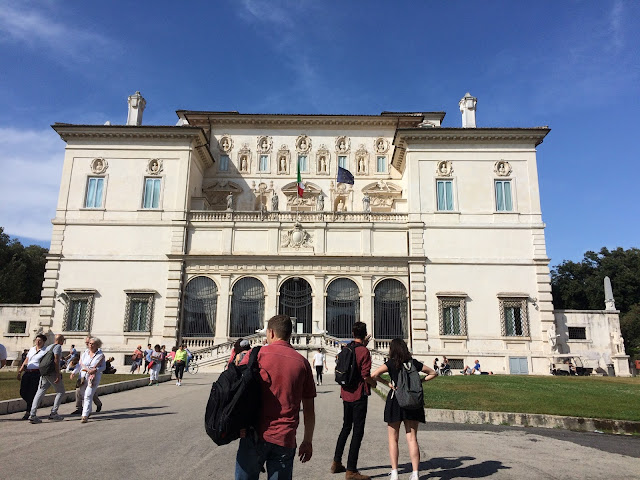


















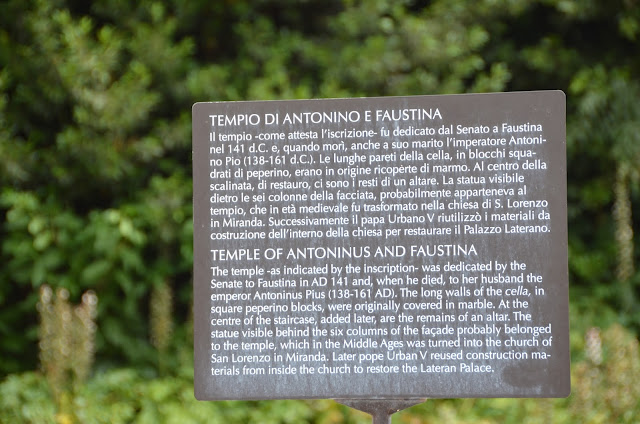














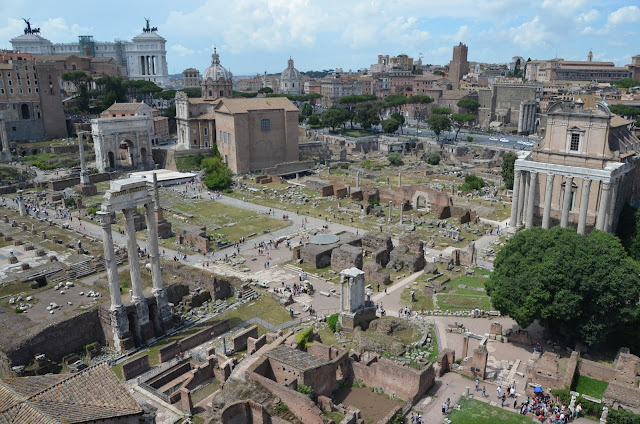


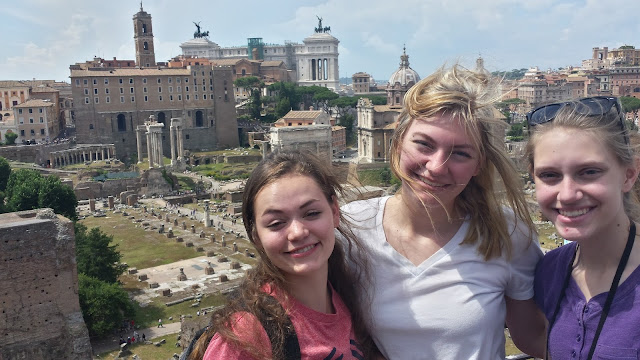




























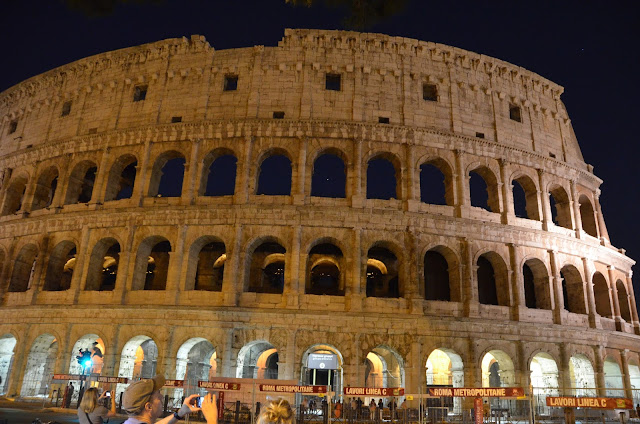
I'm so impressed with your editing skills - we took so many pictures, I can't believe you were able to compress it down to just these. Oh, and when it rains in the Pantheon, they have small holes in the floor to help it drain.
ReplyDelete